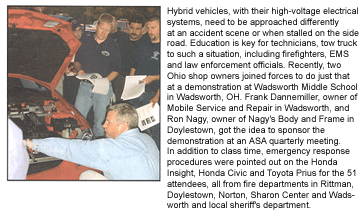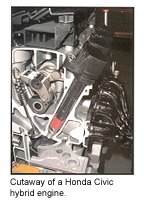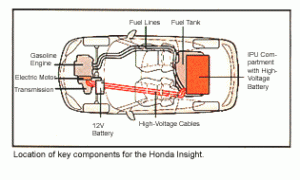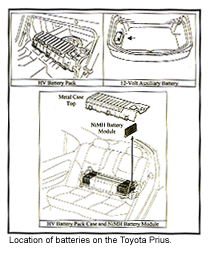
The hybrid concept of combining an internal combustion engine with an electric motor and electric power supply is becoming more popular as vehicle manufacturers look to reduce emissions and fuel consumption in vehicles. Consumer interest in these vehicles has been favorable, which is why you can expect to see more of these types of vehicles on the road and in your shop. However, hybrid vehicles, with their high-voltage electrical systems, need to be approached differently when servicing their motor and engine systems.
As a shop owner, you should familiarize yourself and your technicians with some of the safety and servicing issues surrounding hybrid vehicles. And because some technicians in rural areas and various towns also serve as community firefighters, much of this information will be useful to them should they come across a hybrid involved in an accident.
In this article, we’ll take a look at disabling the high-voltage electrical systems on vehicles that have been racking up miles on U.S. roads – the Honda Insight and Toyota Prius.
When servicing hybrid vehicles, be wise and prepared, not frantic and scared. Both Honda and Toyota have readily available service precautions that you need to read and carefully follow before you work on one of their hybrids.
Toyota Prius
The first-generation Prius (sold in the United States since 2000) is one that you may see in your shop soon. Some shops may already be providing routine scheduled maintenance to this and other hybrid vehicles.
The Prius uses a high-voltage battery pack that’s comprised of 38 modules. Each of these modules contains six 1.2-volt cells. This is a total of 273.6 direct current (DC) volts.
The DC power emitting from the battery pack is channeled through an inverter that regulates the electric current between the motor generators and the high-voltage battery. It actually converts the DC from the battery pack into alternating current (AC) three-phase power.
This current flows both ways because not only does the battery power the motor generators that move the car, but the motor generators charge the high-voltage batteries when you release the throttle. The braking action of the motor generator when you release the throttle is what charges the battery. So, the vehicle becomes more efficient in stop-and-go traffic.
(Note: The new-generation 2004 Prius has been upgraded with a 50-kilowatt electric motor from the earlier 33-kw version. The Prius nickel-metal hydride battery is upgraded, too, to a 500-volt maximum, up from 273.6 volts.)
Disabling the Prius High-Voltage Electrical System
For ease in identification, any electrical cable that carries the 276-volt current is colored orange. Any orange-colored cable should be avoided until the high-voltage electrical system has been disabled. Insulated gloves rated for 5,000 volts and certified to 1,000 volts must be worn whenever touching any high-voltage part of the Prius.
- Remove the ignition key.
- Disconnect the 12-volt battery.
- Put on insulated gloves, then remove any covers that will impede access to the high-voltage service plug located in the hatchback area of the vehicle.
- Turn the orange service plug lever from the 12 o’clock position down 90°.
- Remove the orange service plug and place it in your pocket. Doing this will eliminate the chance that someone else will re-energize the high-voltage system of the vehicle. Wait five minutes for the high-voltage system to discharge.
- Before touching a bare high-voltage terminal, use an electrical tester (voltmeter) to ensure that the terminal is not charged with electricity. Also, Toyota recommends using vinyl electrical tape to insulate any disconnected or exposed high-voltage terminal or connector.
Note: If the rear of the vehicle cannot be accessed due to collision damage, the high-voltage system of the Prius can be disabled from two access points under the hood. One point is the relay junction point located under the vehicle hood along the lower cowl panel. Open the relay box and remove the relay closest to the driver’s side of the vehicle.
The second disabling area is located above the left front wheel in the fuse box. Open the fuse box and remove the high-voltage fuse.
After Service
After servicing the high-voltage system, you’ll need to address a few things before reinstalling the service plug.
- Check that all tools, parts or metal objects have been removed from the vehicle.
- Make certain the high-voltage terminal screws are firmly tightened to the specified torque.
- Inspect all connectors to be sure they are fully engaged.
- Reinstall the service plug and reconnect the cable to the negative terminal of the auxiliary battery.
Honda Insight
The Honda Insight powertrain includes a gasoline engine, a 10-kilowatt electric motor/generator and a compact nickel-metal hydride battery used to supply energy to the Integrated Motor Assist (IMA) system.
The battery is made up of 20 modules that are connected in series. Within each module are six 1.2V cells. Total battery voltage is 144V.
 The battery module has four built-in thermistor-type temperature sensors, and a PTC (positive temperature coefficient)-type temperature sensor for each cell.
The battery module has four built-in thermistor-type temperature sensors, and a PTC (positive temperature coefficient)-type temperature sensor for each cell.
High-voltage DC circuits such as the battery module, junction board, PCU (Power Control Unit), etc. are stored in the IPU (Intelligent Power Unit), which is located at the rear of the car for efficient packaging and for safety.
The motor is a DC brushless type located between the inline, 3-cylinder, SOHC, 12-valve engine and the transmission. In addition to providing assist to the engine, the motor starts the engine and it acts as a generator to recharge the battery.
The MCM (Motor Control Module) controls the motor through the MPI (Motor Power Inverter) module and the voltage control unit. The MCM determines the amount of assist and regenerative power needed by communicating with the BCM (Battery Condition Monitor) module to prevent excessive battery drain and to prevent battery overcharging.
 Like conventional vehicles, the Insight has a 12V battery located under the hood. In addition to powering lights, audio and temperature-control systems, this battery also powers the control systems for the high-voltage battery module.
Like conventional vehicles, the Insight has a 12V battery located under the hood. In addition to powering lights, audio and temperature-control systems, this battery also powers the control systems for the high-voltage battery module.
Note: For safety and ease of identification, electrical cables that carry the 144-volt current are colored orange. Orange-colored cables should be avoided until the high-voltage electrical system has been disabled.
Disabling the Insight High-Voltage Electrical System
- Remove the Battery Module Switch cover plate located on top of the high-voltage battery (under the rear hatch carpet).
- Remove the battery switch lock and turn the Battery Module Switch to the “OFF” position.
- Replace the battery switch lock and Battery Module Switch cover plate. Next, secure a tag to the switch cover plate stating the position of the high-voltage battery switch. A label such as “POWER OFF – DO NOT TOUCH” should alert people to not change the battery switch position.
Other Precautions
- If a hybrid vehicle is in water, DO NOT attempt to disconnect the electrical system. Remove the vehicle from the water and then disconnect the high-voltage electrical system. Following these vehicle makers’ recommendations should help reduce the chance of personal injury.
- These high-voltage batteries are alkaline batteries, unlike the lead acid batteries you’re used to. What this means is that if the cells are ruptured, you’re not going to neutralize the electrolyte with a soda water solution. Instead, you need to neutralize the electrolyte with a boric acid solution.(You can purchase boric acid powder at most drug stores.) The leakage from one of these batteries contains potassium hydroxide. When potassium hydroxide reacts with metals, it produces hydrogen gas. This is flammable – especially in a confined space like the trunk, where the high-voltage battery is located. Potassium hydroxide also is very damaging to skin tissue.Dissolve the boric acid in water until the powder will no longer dissolve. At this point, the water is sufficiently saturated with boric acid to neutralize the alkaline electrolyte. You should use red litmus paper to determine the alkalinity of the spill. When the litmus paper turns blue, this indicates more boric solution should be sprayed on the spill (a spray bottle works well). When the red litmus remains red, you’ve neutralized the electrolyte.
- Don’t expose bare wires – The hybrids have high-voltage cables running from the battery to the motor generators. Don’t cut through the insulation and expose the bare wires. Do locate and inspect the cables for any collision-related damage.
- Thoroughly review the disabling and enabling procedures prior to working on the vehicle.
- Never tow a hybrid with the drive wheels on the ground. This could start a fire. Always follow manufacturer’s recommendations for towing. This may involve disabling the high-voltage system.
Adapted from Mike West’s article in the December 2003 issue of BodyShop Business magazine. Additional information provided by the Automotive Service Association; I-CAR; and emergency response guides for Honda Insight; Honda Civic Hybrid and Toyota Prius.
Down the Road
 Toyota Motor Corp. reported that it is offering its hybrid-electric vehicles to upscale buyers with its first luxury sport-utility due for sale later this year. The company unveiled a hybrid version of its Lexus RX series luxury sport-utility vehicle in January at the Detroit Auto Show. The Japanese automaker will call the car the RX 400h, and said it also is considering either building a hybrid version of its best-selling Camry sedan or second-generation Tundra full-size pickup, due in 2005.
Toyota Motor Corp. reported that it is offering its hybrid-electric vehicles to upscale buyers with its first luxury sport-utility due for sale later this year. The company unveiled a hybrid version of its Lexus RX series luxury sport-utility vehicle in January at the Detroit Auto Show. The Japanese automaker will call the car the RX 400h, and said it also is considering either building a hybrid version of its best-selling Camry sedan or second-generation Tundra full-size pickup, due in 2005.
Hyundai said it plans to launch a hybrid car in the U.S. by 2006, though no word on which model is available.
Honda Motor Co. said it will bring a hybrid-electric version of its popular Accord sedan to the U.S. later this year, as it expands its family of fuel-efficient vehicles. Although the vehicle does not yet have a launch date, it would bring to three the number of hybrids in Honda’s lineup, with one more being considered in the pipeline.
Ford Motor Co. is expected to release its Escape SUV hybrid in the second half of this year, following nearly a year delay of its original release date.
In 2005, General Motors will add “mild hybrid” versions of its full-size pickups with an integrated alternator/starter system that increases fuel economy 12% to 15%.
DaimlerChrysler plans in 2005 to offer a hybrid Dodge Ram pickup called the Contractor Special with an onboard generator.
GM will add a hybrid Saturn Vue SUV in 2006 with 12% to 15% better fuel economy, up from 23 mpg now. Like the Lexus, Toyota and Ford SUVs that will get hybrid systems, the Vue is based on a car platform.
In 2007, GM said it will offer hybrid versions of the Chevrolet Tahoe and GMC Yukon full-size, truck-based SUVs with 25% to 35% higher fuel economy, up from 16 mpg now. GM will put the same system on its full-size pickups in 2008.
Source: Associated Press
